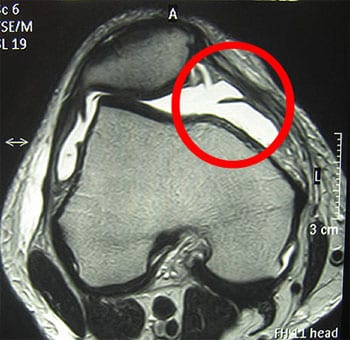Plica Syndrome
The plica is a small fold in the synovial lining of the knee joint found in approximately 50-70% of adults.
When a plica is highly pronounced, it can cause painful irritation, particularly if the knee joint is overstressed. This is often called plica syndrome.
The swollen tissue rubs against the cartilage and, in the long term, can result in early onset arthritis.
Plica syndrome is mainly treated conservatively, however, if symptoms persist or if the plica is highly pronounced, surgical treatment can be advised.
More questions?
Our experts are happy to help you
Just give us a call!
As with all joints, the knee joint is covered by a thin, smooth layer of skin. This so-called synovial membrane produces articular fluid, which prevents friction in the joint and supplies the joint cartilage with nutrients.
During embryonic development, the synovial membrane forms a barrier that divides the knee joint into two separate areas. (This is a holdover from the time when life emerged from the oceans and began moving on all fours. Horses, for example, still have two-part knee joints). Normally, this membrane diminishes entirely by the end of a child’s development, thus allowing for greater freedom of movement in the knee. However, in about 50 - 70% of adults, a small fold of tissue - called a plica - remains. This is usually located behind, above, or inside (medial) the kneecap.
Many people who have a plica have no problems at all, however, if the plica is more prominent, this can lead to irritations. Above all, overstraining of the knee joint leads to irritation of the plica and therefore to so-called Plica Syndrome. Demanding activities in which the knee is repeatedly flexed and then extended again (such as running, cycling, or exercises on "steppers") are the most frequent causes.
The plica itself, as well as the tissue around it, swells and becomes painful. The thickening then rubs on the cartilage inside the knee joint and can damage the joint cartilage or cause joint inflammation (arthritis) if exertion is continued.
The most common symptoms of plica syndrome are
- Pain on exertion, mostly on the medial or posterior side of the patella
- "Creaking" or "clicking" of the joint in a specific position while flexing it
- A "blocking" sensation during extension movements
- Stiffness in the joint after sitting for long periods
- In some cases, the thickened plica can also be felt under the skin, or swelling of the entire knee joint occurs.
DIAGNOSIS
To diagnose plica syndrome, one must first locate the pain with precision and determine whether thickening has occurred in the patellar area. Once can often also feel the rubbing of the plica in the knee joint on movement. Pain when tensing the thigh musculature is typical, if the examiner presses the patella against the articular surface at the same time (positive Zohlen test). This test, however, can also be positive in the case of retropatellar cartilage damage - and 50% of all patients generally find it very uncomfortable to undergo the test.
An MRI examination can also be helpful for diagnosis, however it does not always yield clear findings. For some patients, definite proof of plica syndrome can only be found through Arthroscopy (Kniegelenksspiegelung).

TREATMENT
Non-surgical therapy and treatment of the inflammatory irritation can be carried out in a first step. Rest must be prescribed here, in combination with treatment with anti-inflammatory medication. Cooling with ice is also helpful and alleviates pain and swelling.

The problem with plica syndrome in athletic patients, however, is that symptoms often do not improve, as inflammation has altered and hardened the edge of the plica, causing it to continue rubbing on the cartilage, and destroying it. An operation (arthroscopy) should therefore be considered early on for athletic patients. The plica is removed and the symptoms usually improve after a very short time - unless significant cartilage damage has already occurred.
It should be explained to the patient prior to operation that they may still have pain after the operation (due to cartilage damage). The majority of patients, however, are very happy to find that, following the minor arthroscopic operation, the pain, which has often been part of their life for years, has suddenly completely disappeared.
More questions?
Our experts are happy to help you
Just give us a call!





